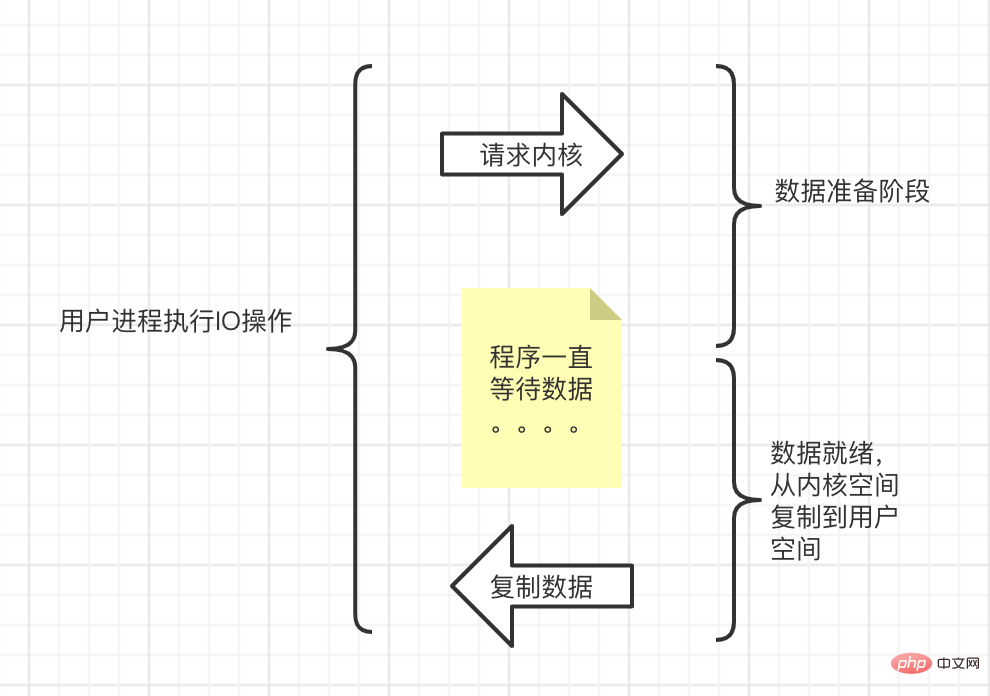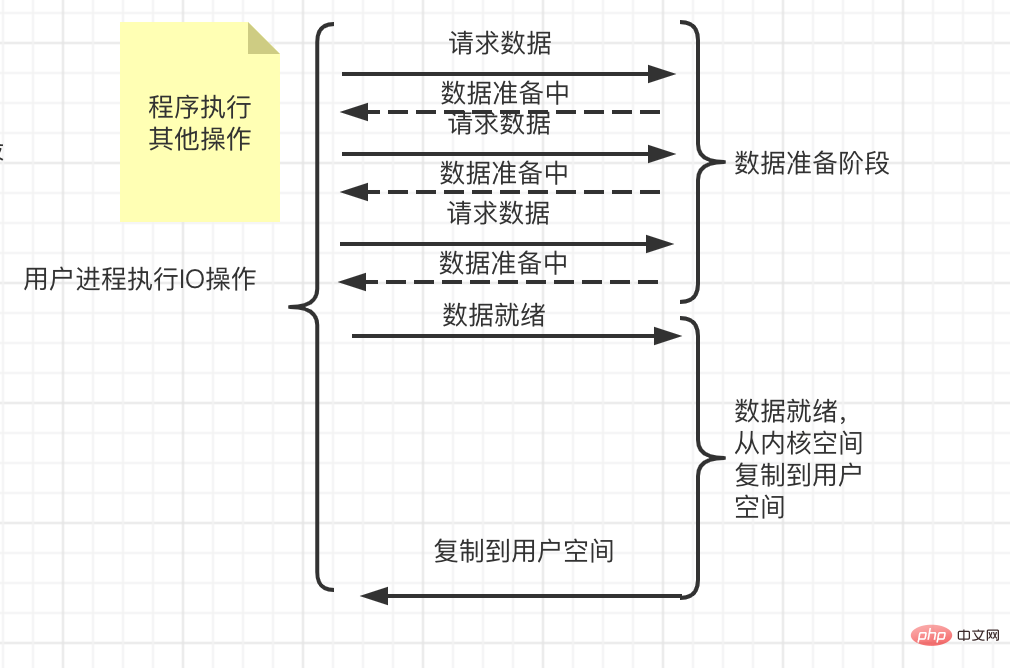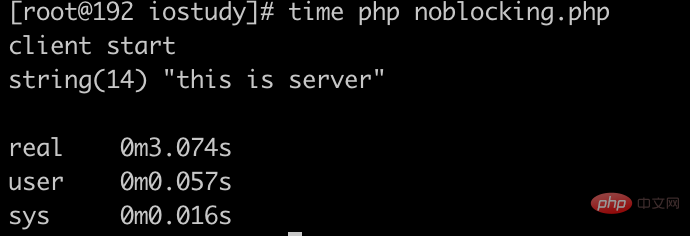 Backend Development
Backend Development
 PHP Problem
PHP Problem
 Detailed introduction to PHP's five IO models: blocking and non-blocking
Detailed introduction to PHP's five IO models: blocking and non-blocking
Detailed introduction to PHP's five IO models: blocking and non-blocking
This article will give you a detailed introduction to the blocking and non-blocking of PHP's five major IO models. It has certain reference value. Friends in need can refer to it. I hope it will be helpful to everyone.

Blocking: It means that the application needs to complete the IO operation before returning to the user space.
Non-blocking: It means that the application is blocked when performing the IO operation. A status value is returned to the user immediately after the call, without waiting for the IO operation to be completely completed.
Blocking model:

Non-blocking mode:

In blocking mode, the user process will It keeps waiting for kernel state data, so the efficiency is extremely low. For example: when Xiao Ming wants to boil water, he has to wait for the water to boil. But in fact, Xiao Ming can do other things during the process of boiling water.
An optimization is non-blocking mode. After the user process performs an IO operation, the kernel state will immediately return a value, which is usually empty. The user process can do other things until the kernel state data is ready. Request to get the real execution results. Taking the example of Xiao Ming above, when Xiao Ming is boiling water, he can read a book, look for a while to see if the water is boiling, check whether the water is boiling, and at the same time he can read a book and study.
Performance analysis:
Suppose a program needs to perform two operations a and b, where a needs to perform IO operations and b does not. In blocking mode, the time consumed is equal to a b, while in non-blocking mode, it is equal to the maximum time consuming operation in a and b.
Server code:
$server = stream_socket_server('tcp://127.0.0.1:9999', $erron, $error);
while (true) {
$conn = stream_socket_accept($server);
if ($conn) {
$data = fread($conn, 65535);
echo $data;
sleep(3);
fwrite($conn, 'this is server');
fclose($conn);
}
}Blocking client:
function operation()
{
sleep(2);
}
echo "client start n";
$client = stream_socket_client('tcp://127.0.0.1:9999', $erron, $error, 60);
fwrite($client, "is client 1n");
echo fread($client, 65535);
operation();
fclose($client);Non-blocking client:
function operation()
{
sleep(2);
}
echo "client start n";
$client = stream_socket_client('tcp://127.0.0.1:9999', $erron, $error, 60);
stream_set_blocking($client, 0);//设置非阻塞
fwrite($client, "is client 1n");
operation();
while (!feof($client)) {
sleep(1);
var_dump(fread($client, 65535));
}
fclose($client);Time consumption:
Blocking Mode

Non-blocking mode

Recommended learning: php video tutorial
The above is the detailed content of Detailed introduction to PHP's five IO models: blocking and non-blocking. For more information, please follow other related articles on the PHP Chinese website!

Hot AI Tools

Undresser.AI Undress
AI-powered app for creating realistic nude photos

AI Clothes Remover
Online AI tool for removing clothes from photos.

Undress AI Tool
Undress images for free

Clothoff.io
AI clothes remover

Video Face Swap
Swap faces in any video effortlessly with our completely free AI face swap tool!

Hot Article

Hot Tools

Notepad++7.3.1
Easy-to-use and free code editor

SublimeText3 Chinese version
Chinese version, very easy to use

Zend Studio 13.0.1
Powerful PHP integrated development environment

Dreamweaver CS6
Visual web development tools

SublimeText3 Mac version
God-level code editing software (SublimeText3)

Hot Topics
 1386
1386
 52
52
 PHP 8.4 Installation and Upgrade guide for Ubuntu and Debian
Dec 24, 2024 pm 04:42 PM
PHP 8.4 Installation and Upgrade guide for Ubuntu and Debian
Dec 24, 2024 pm 04:42 PM
PHP 8.4 brings several new features, security improvements, and performance improvements with healthy amounts of feature deprecations and removals. This guide explains how to install PHP 8.4 or upgrade to PHP 8.4 on Ubuntu, Debian, or their derivati
 How To Set Up Visual Studio Code (VS Code) for PHP Development
Dec 20, 2024 am 11:31 AM
How To Set Up Visual Studio Code (VS Code) for PHP Development
Dec 20, 2024 am 11:31 AM
Visual Studio Code, also known as VS Code, is a free source code editor — or integrated development environment (IDE) — available for all major operating systems. With a large collection of extensions for many programming languages, VS Code can be c
 7 PHP Functions I Regret I Didn't Know Before
Nov 13, 2024 am 09:42 AM
7 PHP Functions I Regret I Didn't Know Before
Nov 13, 2024 am 09:42 AM
If you are an experienced PHP developer, you might have the feeling that you’ve been there and done that already.You have developed a significant number of applications, debugged millions of lines of code, and tweaked a bunch of scripts to achieve op
 How do you parse and process HTML/XML in PHP?
Feb 07, 2025 am 11:57 AM
How do you parse and process HTML/XML in PHP?
Feb 07, 2025 am 11:57 AM
This tutorial demonstrates how to efficiently process XML documents using PHP. XML (eXtensible Markup Language) is a versatile text-based markup language designed for both human readability and machine parsing. It's commonly used for data storage an
 Explain JSON Web Tokens (JWT) and their use case in PHP APIs.
Apr 05, 2025 am 12:04 AM
Explain JSON Web Tokens (JWT) and their use case in PHP APIs.
Apr 05, 2025 am 12:04 AM
JWT is an open standard based on JSON, used to securely transmit information between parties, mainly for identity authentication and information exchange. 1. JWT consists of three parts: Header, Payload and Signature. 2. The working principle of JWT includes three steps: generating JWT, verifying JWT and parsing Payload. 3. When using JWT for authentication in PHP, JWT can be generated and verified, and user role and permission information can be included in advanced usage. 4. Common errors include signature verification failure, token expiration, and payload oversized. Debugging skills include using debugging tools and logging. 5. Performance optimization and best practices include using appropriate signature algorithms, setting validity periods reasonably,
 PHP Program to Count Vowels in a String
Feb 07, 2025 pm 12:12 PM
PHP Program to Count Vowels in a String
Feb 07, 2025 pm 12:12 PM
A string is a sequence of characters, including letters, numbers, and symbols. This tutorial will learn how to calculate the number of vowels in a given string in PHP using different methods. The vowels in English are a, e, i, o, u, and they can be uppercase or lowercase. What is a vowel? Vowels are alphabetic characters that represent a specific pronunciation. There are five vowels in English, including uppercase and lowercase: a, e, i, o, u Example 1 Input: String = "Tutorialspoint" Output: 6 explain The vowels in the string "Tutorialspoint" are u, o, i, a, o, i. There are 6 yuan in total
 Explain late static binding in PHP (static::).
Apr 03, 2025 am 12:04 AM
Explain late static binding in PHP (static::).
Apr 03, 2025 am 12:04 AM
Static binding (static::) implements late static binding (LSB) in PHP, allowing calling classes to be referenced in static contexts rather than defining classes. 1) The parsing process is performed at runtime, 2) Look up the call class in the inheritance relationship, 3) It may bring performance overhead.
 What are PHP magic methods (__construct, __destruct, __call, __get, __set, etc.) and provide use cases?
Apr 03, 2025 am 12:03 AM
What are PHP magic methods (__construct, __destruct, __call, __get, __set, etc.) and provide use cases?
Apr 03, 2025 am 12:03 AM
What are the magic methods of PHP? PHP's magic methods include: 1.\_\_construct, used to initialize objects; 2.\_\_destruct, used to clean up resources; 3.\_\_call, handle non-existent method calls; 4.\_\_get, implement dynamic attribute access; 5.\_\_set, implement dynamic attribute settings. These methods are automatically called in certain situations, improving code flexibility and efficiency.



